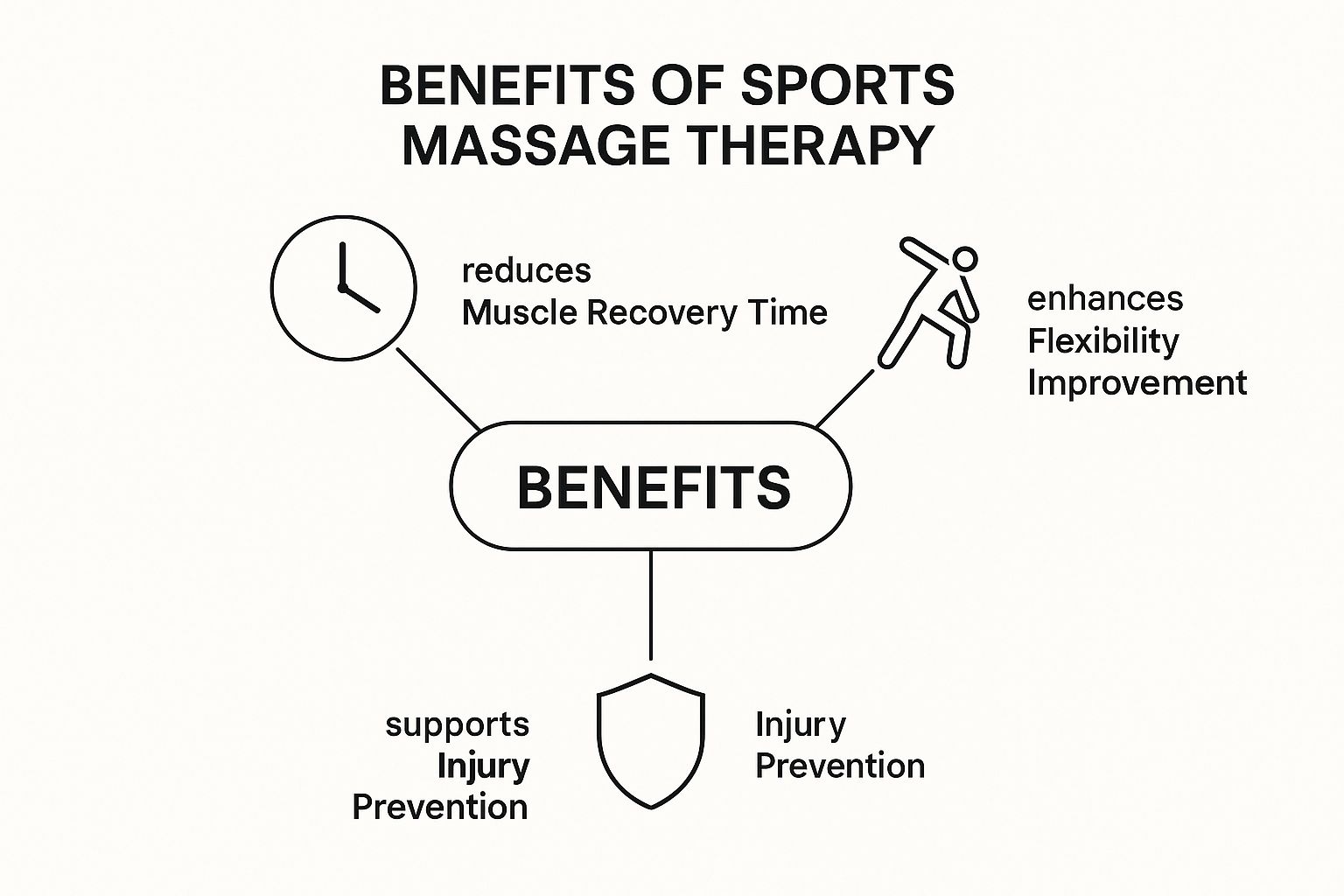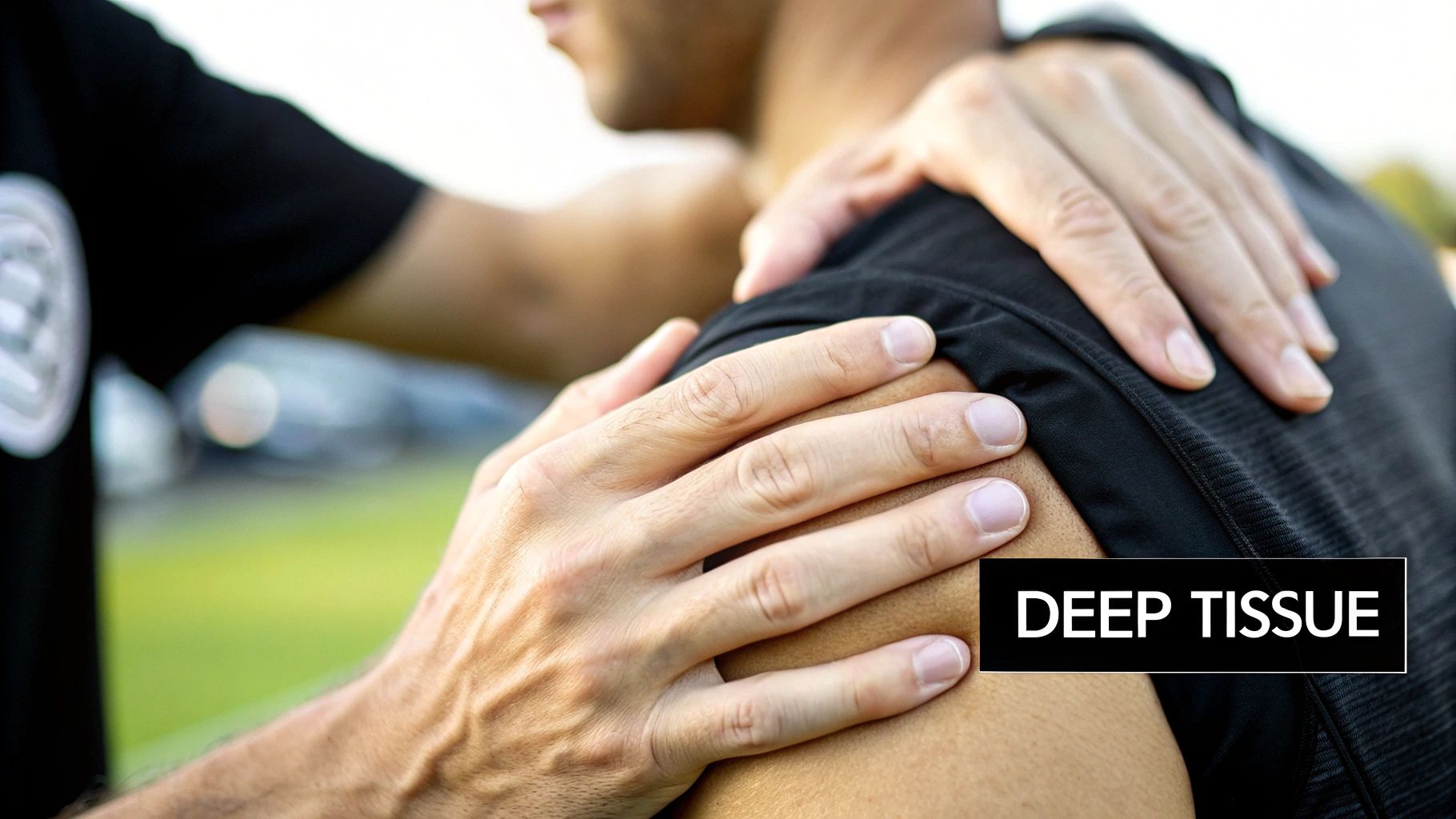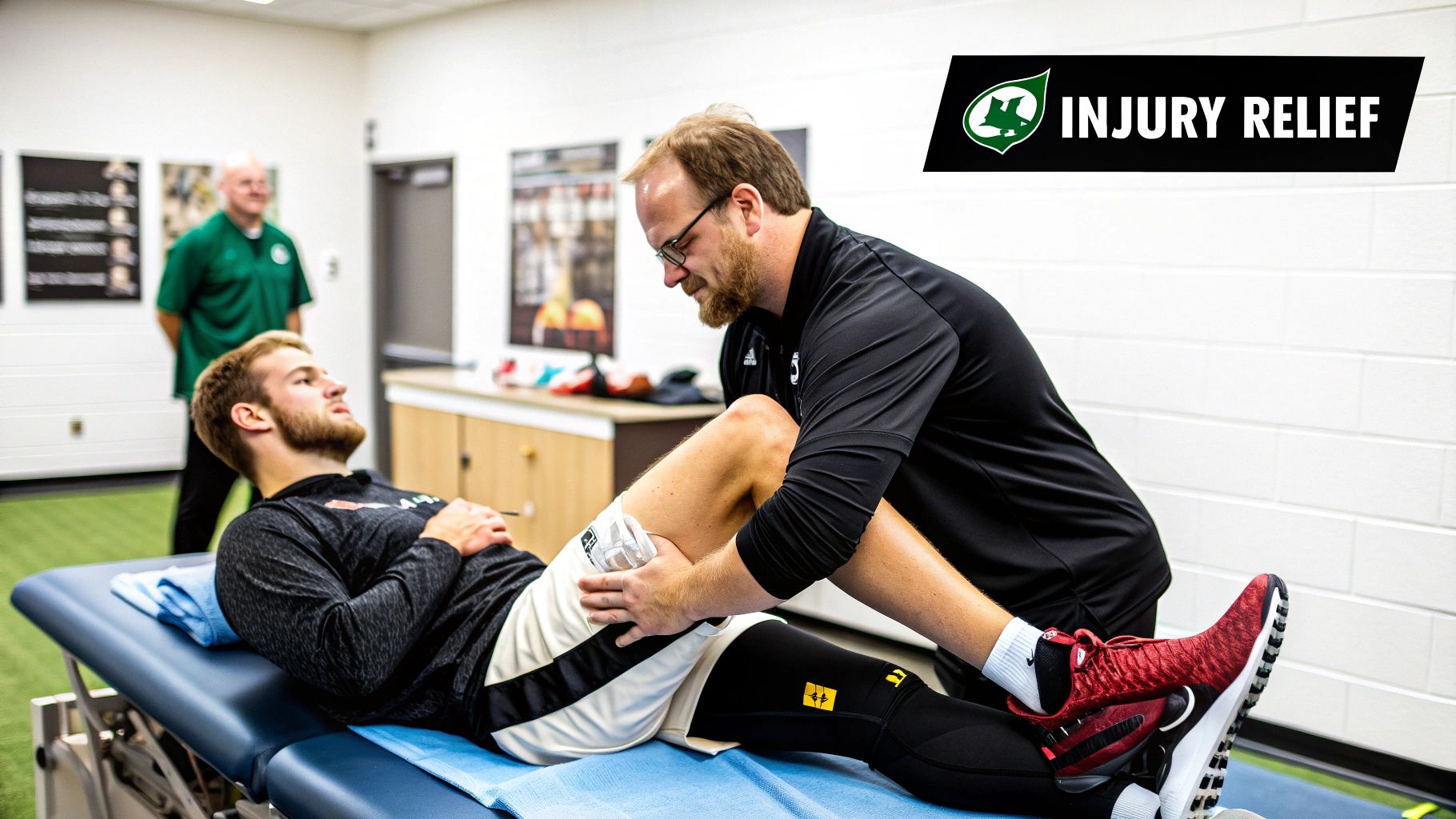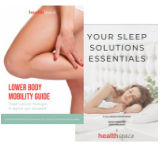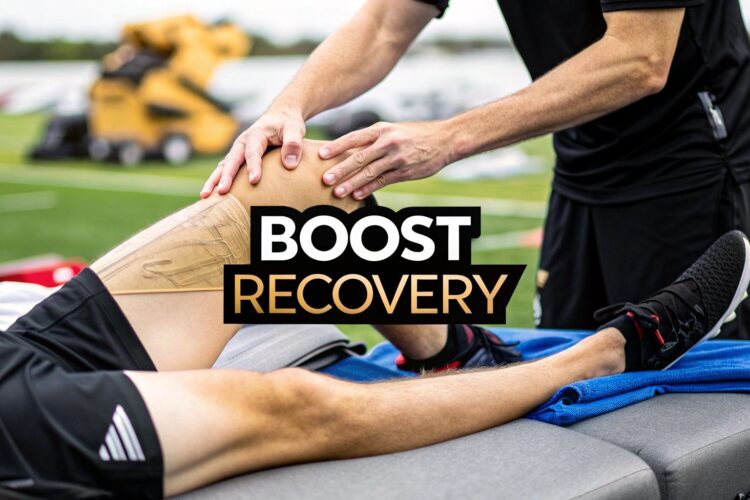
Understanding Sports Massage Therapy Beyond The Surface
To get what sports massage therapy is all about, it helps to first understand how it differs from other treatments. While you can learn about the distinctions between sport and deep tissue massage, the main difference comes down to purpose. Think of a standard massage as a general tune-up for your car to keep it running smoothly. Sports massage, on the other hand, is like the specialised work a mechanic does for a high-performance race car. It’s not just about overall maintenance; it’s about fine-tuning every single part for a specific outcome, like winning a race or preventing a breakdown under pressure.
This targeted approach means sports massage is a world away from a relaxing spa day. It’s a functional, outcome-based form of bodywork. The practitioner isn’t simply trying to ease general tightness. They’re conducting a detailed assessment to understand your sport, how you move, and what you want to achieve. They’re digging for the ‘why’ behind your pain or restriction, not just treating the symptom.
A Purpose-Driven Partnership
Unlike a one-off relaxation session, sports massage therapy is usually part of a bigger picture. It’s a partnership between you and your therapist, built to support your athletic goals. This might involve preparing your muscles for a major event, helping you recover after an intense competition, or performing regular maintenance to stop injuries from developing in the first place. This focus on function makes it a vital tool for athletes at every level, from weekend warriors to elite professionals.
This therapeutic role is increasingly acknowledged within Australia’s primary healthcare system. For example, recent research shows that for patients needing treatment for pain and dysfunction, between 52% and 63% receive a course of three to five massage therapy sessions. A further 15% to 29% require six to ten sessions. These figures show how targeted manual therapy is a critical part of managing sports-related injuries and staying in peak physical condition. You can read the full findings on the vital role of massage therapists in primary care on Mirage News. This shift proves that sports massage is seen less as a luxury and more as a necessary part of an athlete’s health and performance strategy.
The Real Science Behind Sports Massage Therapy
Have you ever wondered what is actually going on beneath the surface when a skilled therapist applies targeted pressure? Far from being just a relaxing experience, sports massage therapy is a precise discipline based on physiological responses. It is less about general relaxation and more about creating specific, measurable changes within your body’s tissues and nervous system.
Think of it as a direct conversation with your muscles. Your therapist uses the language of touch to send clear signals that influence how your body recovers and performs. This targeted approach works on several levels. Mechanically, the pressure helps increase blood and lymph flow. Imagine a congested motorway during peak hour; massage helps clear the traffic, allowing fresh, oxygenated blood to reach tired muscles while flushing out metabolic waste products like lactic acid. This improved circulation is a key reason why athletes report feeling less sore and recovering faster after a tough session.
Neurological and Cellular Impact
Beyond just moving fluids around, sports massage therapy also has a significant effect on your nervous system. When a therapist works on a tight, knotted muscle, they are directly influencing the nerve receptors within that tissue. This can help to break the stubborn pain-spasm-pain cycle, where pain causes a muscle to tense up, which in turn causes more pain.
By applying specific techniques, the therapist can interrupt these signals, encouraging the muscle to relax and ‘reset’ its natural tension level. Research has shown that this process can reduce delayed onset muscle soreness (DOMS) and improve an athlete’s sense of recovery.
This concept map visualises the interconnected benefits of sports massage, from recovery to prevention.
The graphic clearly shows how improving recovery and flexibility directly contributes to the overarching goal of injury prevention. Ultimately, these physiological mechanisms work together to create an environment where your body can heal more efficiently, adapt to training loads more effectively, and perform at its best. It’s this combination of mechanical and neurological effects that makes sports massage therapy a legitimate form of performance medicine.
Benefits That Transform Your Athletic Journey
While getting rid of aches and pains is a major reason people seek sports massage, its real power is in the collection of benefits that can reshape your entire athletic life. The advantages go well beyond the massage table, building a positive cycle of better performance, faster recovery, and a stronger defence against future injuries. Think of it less as a quick fix and more as a long-term investment in your body’s resilience and potential.
The most noticeable benefit is often improved muscle recovery. After a tough workout or competition, your muscles are full of metabolic by-products that cause soreness. Sports massage works to improve circulation, helping to flush out these waste products while bringing in fresh, oxygen-rich blood. This process can reduce the intensity and length of delayed onset muscle soreness (DOMS), getting you back to training sooner and feeling stronger.
Enhancing Performance and Preventing Injury
Beyond just helping you bounce back, regular sessions can lead to real improvements in your performance. Here’s how:
- Increased Flexibility and Range of Motion: Specialised techniques work on releasing tight spots and breaking down scar tissue in muscles and fascia. This brings back elasticity, letting your joints move more freely and efficiently.
- Improved Proprioception: Sports massage stimulates the nerve receptors in your muscles and tendons, sharpening your body’s internal GPS. This heightened awareness of where your limbs are in space leads to better coordination and smoother movements.
- Reduced Injury Risk: By keeping muscles supple and identifying potential trouble spots before they become full-blown injuries, sports massage therapy serves as a powerful preventative measure.
Sports massage can also be a focused strategy to help with healing and pain management for certain issues. A therapist can use techniques for addressing specific conditions like Achilles tendinopathy as an important part of a wider recovery plan.
Psychological and Systemic Advantages
The perks aren’t just physical. Regular massage has been shown to lower levels of the stress hormone cortisol while boosting serotonin and dopamine, which can improve your mood and mental clarity. This mental edge is vital for both competition day and staying consistent with your training.
This growing appreciation for complete athletic care is seen in market trends. The Australian sports medicine industry, which includes services like sports massage, brought in around USD 58.2 million in 2024 and is expected to more than double by 2033. This shows the rising demand for therapies that keep athletes at the top of their game. You can find more details about the growing sports medicine market on Future Market Insights. To support this physical therapy, you can also explore the role of nutrition in sports injury recovery to build a complete wellness strategy.
Reading Your Body’s Signals For Sports Massage Therapy
Your body is in a constant state of communication, sending you subtle messages through muscle tension, movement quality, and overall performance. Learning to read these signals is the key to understanding when sports massage therapy can provide the most benefit. It’s about shifting from a reactive approach—waiting for pain to appear—to a proactive one where you deal with minor issues before they can sideline you.
Think of your body as a high-performance vehicle; you wouldn’t wait for the engine to start smoking before checking the oil. Some signals are obvious, like a muscle that stays stubbornly tight for days after a workout or a dull ache that never seems to fully go away. Others are more subtle but just as important. Maybe you’ve noticed your squat isn’t as deep as it once was, or your golf swing feels slightly restricted. These small changes in your range of motion are early warnings that your tissues are becoming restricted.
Recognising Key Indicators
By paying close attention to these indicators, you can time your massage sessions for maximum impact. Here are some common signs that your body is signalling it’s time for a targeted sports massage:
- Persistent Muscle Soreness: If soreness lingers for more than 72 hours after a workout, it’s a clear sign your muscles are struggling to recover on their own.
- Decreased Flexibility: You find it harder to touch your toes, or your shoulders feel tight when you reach overhead. This gradual loss of mobility can be a precursor to injury.
- Performance Plateaus: You’ve hit a wall in your training. You can’t seem to lift heavier, run faster, or refine your form, often because of underlying muscle fatigue or restrictions.
- Nagging Aches and Pains: Those minor, annoying pains that are easy to ignore can be early signs of developing overuse injuries that need attention.
Timing Your Sessions for Peak Performance
Your training schedule, competition calendar, and injury history are all factors that influence your massage needs. A maintenance massage during a heavy training block will have a very different goal than a pre-event session designed to prime your muscles for competition. Understanding these distinctions allows you to use sports massage as a strategic tool for performance and recovery.
To help you plan, we’ve created a guide that outlines recommended massage timings based on your activity level and goals.
Sports Massage Therapy Timing Guide For Different Activities
Recommended sports massage scheduling based on training intensity, competition timeline, and recovery goals
| Activity Level | Pre-Event Timing | Post-Event Timing | Maintenance Frequency |
|---|---|---|---|
| Weekend Warrior / Casual Athlete | 1-2 days before a big event or activity. | 24-48 hours after to aid recovery. | Every 4-6 weeks to address general tightness. |
| Consistent Gym-Goer / Amateur Athlete | 2-3 days before a competition or race. | Within 24 hours to reduce inflammation and soreness. | Every 2-4 weeks during training blocks. |
| Professional / Elite Athlete | 3-5 days before major competitions. | Within 2-24 hours post-event, followed by a deeper session 48-72 hours later. | Weekly or bi-weekly, depending on training intensity. |
| Injury Rehabilitation | Not applicable; focus is on therapeutic timing. | Not applicable; focus is on therapeutic timing. | 1-2 times per week initially, then tapering as function returns. |
This table provides a solid starting point for scheduling your sessions to align with your athletic pursuits. By matching the timing to your specific needs, you can ensure your body is prepared for the demands of training and competition.
Learning to interpret your body’s signals is a vital part of staying healthy and active. This awareness forms a key component of a broader injury prevention strategy. To build on this, you can discover more ways to protect your body by reading our guide on five methods for preventing injury during athletics season. By listening to your body and responding with the right support, you empower yourself to train smarter and perform better.
Your Complete Sports Massage Therapy Experience
Walking into your first sports massage therapy appointment shouldn’t feel intimidating. Knowing what to expect from beginning to end helps you relax and get the most from every session. It’s a partnership between you and your therapist, starting with a detailed assessment that lays the groundwork for a truly effective treatment.
The Initial Assessment: More Than Just Talk
Your first session will always begin with a conversation and a physical evaluation. This isn’t just a formality; it’s the foundation of your treatment plan. Your therapist will want to understand your world, asking about:
- Your specific sport or activity level
- Your training schedule and any upcoming events
- Any current aches, pains, or recent injuries
- What you hope to achieve with your performance and recovery
After the chat, the therapist will likely guide you through a movement assessment. This might involve simple actions like a squat, a lunge, or reaching your arms overhead. Think of it as a diagnostic check for your body. They are watching for asymmetries, areas of restriction, or compensation patterns that could be the hidden source of your issues. This thorough evaluation allows them to target the root cause, not just the symptoms.
During the Treatment: Communication Is Key
Unlike a general relaxation massage, a sports massage therapy session can feel quite intense at times. The therapist uses targeted techniques to get into deep-seated tension and break down stubborn knots or adhesions. You might feel a sensation often described as a “good hurt”—a deep, productive pressure that feels like it’s making a difference, without being sharp or harmful.
It is vital to maintain an open line of communication throughout the session. Using a pain scale from 1 to 10 is a simple way to give feedback. A level 7 or 8 is often the sweet spot where real change happens, but everyone is different. Your input lets the practitioner adjust their pressure to a level that is both tolerable and therapeutic, ensuring the treatment works with your body, not against it.
Aftercare and Maximising Your Results
The benefits of your massage continue long after you leave the clinic. Your therapist will provide aftercare advice, which is essential for locking in the positive changes from your session. This typically includes:
- Hydration: Drinking plenty of water is crucial. It helps your body flush out the metabolic by-products that were released from your muscle tissues.
- Gentle Movement: Light activity, such as a casual walk, can help prevent stiffness and keep your newly mobile muscles feeling good.
- Avoid Strenuous Activity: Give your body 24-48 hours to recover and adapt before you jump into your next intense workout or training session.
It’s completely normal to feel a bit tender for a day or two, much like the feeling after a challenging workout. This is a positive sign that the therapy has initiated a healing response in your tissues. By following your therapist’s advice, you help your body fully integrate the work, leading to lasting improvements in mobility and pain relief. For more strategies on this, our guide on effective recovery for performance offers excellent tips that pair perfectly with your hands-on therapy.
Finding Your Ideal Sports Massage Therapy Practitioner
Choosing a practitioner for sports massage therapy is a bit different from picking a place for a standard relaxation massage. The right professional can help you unlock your performance potential, while the wrong one can be a frustrating exercise in wasted time and money. Think of it like hiring a specialist mechanic for a high-performance race car; you wouldn’t trust just any garage with an engine built for the track. The goal is to find someone who not only has the right qualifications but also genuinely understands the unique demands placed on athletic bodies.
Qualifications and Background: What to Look For
Practitioners in the world of sports massage come from a variety of professional backgrounds. Some are physiotherapists who have added specialised massage training to their skillset, while others are dedicated sports or remedial massage therapists, often with personal experience in athletics. Neither path is automatically better, but their background does shape their approach. A physio might place more emphasis on diagnosing an injury and planning its rehabilitation, whereas a dedicated sports massage therapist may have a more hands-on focus on performance, maintenance, and pre-event preparation.
No matter their primary title, these are the non-negotiable credentials you should check for:
- Formal Qualification: Look for a Diploma of Remedial Massage or an Advanced Diploma. This proves they have a strong grasp of anatomy, physiology, and therapeutic techniques.
- Association Membership: Practitioners registered with professional bodies like Massage & Myotherapy Australia (MMA) or the Australian Massage Therapists (AMT) must follow a code of ethics and commit to ongoing professional development.
- Insurance: Always confirm they hold current professional indemnity and public liability insurance. This is a basic but essential sign of a professional practice.
Questions to Ask and Red Flags to Spot
Your first appointment is a great opportunity to interview a potential therapist. A good practitioner will be open to your questions and happy to discuss their methods. Be ready to ask things like:
- What is your experience working with athletes in my particular sport?
- How would you approach a new client with my goals (e.g., preparing for a marathon, recovering from an injury)?
- What does a typical treatment plan involve?
Be cautious of any red flags, such as a practitioner who suggests a generic, one-size-fits-all treatment, seems dismissive of your goals, or can’t clearly explain their techniques. The field of sports massage is healthy and expanding, which points to a high demand for skilled professionals. In fact, Australian government data shows steady growth in qualified massage therapists who specialise in health, fitness, and sports injuries. You can learn more about the workforce trends for massage therapists from Jobs and Skills Australia.
This growing industry means you have plenty of great options. Don’t feel pressured to settle for the first therapist you find. Take your time to find a professional who feels like a true partner in your athletic journey.
Making Sports Massage Therapy Work For Your Goals
The best sports massage therapy program is one that becomes a regular part of your routine, tailored to your unique athletic goals. A smart approach weaves this therapy into your training schedule, budget, and lifestyle. Think of it less as a one-off fix and more as building a personalised support system for your body. The real key is consistency and ensuring the therapy aligns with your ambitions, whether you’re training for your first 10k or competing at an elite level.
Integrating Therapy for Long-Term Success
To get the most out of your sessions, view sports massage as a single piece of a larger performance and recovery puzzle. It delivers the best results when paired with other smart strategies. This involves tracking your progress not just in your training log, but also in how your body feels. Take note of changes in your range of motion, how well you sleep, and how quickly you recover after tough workouts. These are the true measures of success.
Reaching your athletic potential often requires a holistic approach. Sports massage therapy complements other tactics like optimised nutrition and supplementation, a topic explored in detailed performance guides. It’s all about creating a supportive ecosystem for your body. This includes:
- Combining modalities: Pair your massage with foam rolling, stretching, or even contrast water therapy (hot and cold baths) to extend the benefits between appointments.
- Listening to your body: Learn to recognise the difference between needing a general maintenance session and requiring targeted treatment for a new ache or niggle.
- Communicating with your therapist: Keep your practitioner updated on your training load and any new issues. This allows them to adjust their techniques to better suit your needs.
Maintaining Momentum and Adapting Your Plan
Holding onto the benefits of sports massage therapy requires a proactive approach, not a passive one. The profession itself is expanding to keep up with the demands of athletes. This chart from Jobs and Skills Australia projects significant growth in the massage therapist workforce.
This data points to a strong future for the field, with employment numbers forecast to increase by 9.1% in the coming years. As your own athletic journey changes, so should your therapy plan. The program that supported you during the off-season will need tweaking as you ramp up for a competition. Stay engaged, pay attention to the signals your body is sending, and work with your therapist to keep your plan aligned with your goals.
A well-designed sports massage plan is a powerful tool for any athlete. If you’re ready to build a personalised strategy to manage pain and improve your performance, our team of accredited practitioners is here to help.
